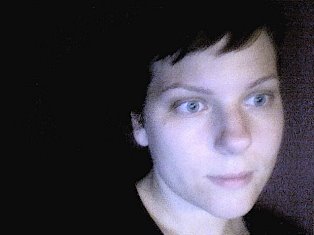New York born and raised, Nicolas Collins studied composition with Alvin Lucier at Wesleyan University, worked for many years with David Tudor, and has collaborated with numerous soloist and ensembles around the world. He lived most of the 1990s in Europe, where he was Visiting Artistic Director of Stichting STEIM (Amsterdam), and a DAAD composer-in-residence in Berlin. Since 1997 he has been editor-in-chief of the Leonardo Music Journal. He is currently Chair of the Department of Sound at the School of the Art Institute of Chicago. Recent recordings are available on PlateLunch, Periplum and Apestaartje.
Nicolas Collins
The Talking Cure
Chicago duo version, May 2004
For many years I’ve been using spoken texts in my music. The voice lends its own sonic qualities, and triggers or controls other sounds (usually electronic, often via computer mediation) to generate extensions and elaborations of the melody and rhythm of natural speech. Narrative content provides form and direction: the hypnotic, often soporific seduction of a good story became central to both life and music while I was raising my small children through the 1990s.
I scavenged and collaged found texts from a wide range of authors – neurologists, poets, mystery writers, historians – and penned a few myself, or in collaboration with my author-wife Susan Tallman. Until recently, however, the words were always fixed before I went on stage. The rest of my performance activities incorporate a fair degree of ad hoc decision making and improvisation, so a few years ago I decided to develop a musical strategy for “improvised talking.”
In “The Talking Cure” a computer follows the inflection and phoneme content of the voice and generates a piano accompaniment that, to my ear, sounds like Charles Ives working a cocktail lounge. The computer also records certain specific speech sounds, which can be played back later to overlay a vaguely instrumental solo line, inspired by the extraordinary trumpet style of Axel Dörner. Sometimes I begin the performance with a family letter or a newspaper article in hand as a conceptual point of departure; other times I prepare nothing. I hold forth for 15-25 minutes and the computer does the rest, making music off my cuff.
The title derives from an early euphemism for Freudian psychoanalysis. Freud advised the patient to “utter without obstruction the thoughts and ideas rising to his mind,” which is pretty much the advice I follow on stage.
For this performance I will be joined by Jonathan Chen in the triple role of fellow patient, analyst and violinist.
*********************************************************************************
Friday May 14, 9pm: Discrete Series features Nic Collins & Judd Morrissey.
*********************************************************************************
Nicolas Collins
The Talking Cure
Chicago duo version, May 2004
For many years I’ve been using spoken texts in my music. The voice lends its own sonic qualities, and triggers or controls other sounds (usually electronic, often via computer mediation) to generate extensions and elaborations of the melody and rhythm of natural speech. Narrative content provides form and direction: the hypnotic, often soporific seduction of a good story became central to both life and music while I was raising my small children through the 1990s.
I scavenged and collaged found texts from a wide range of authors – neurologists, poets, mystery writers, historians – and penned a few myself, or in collaboration with my author-wife Susan Tallman. Until recently, however, the words were always fixed before I went on stage. The rest of my performance activities incorporate a fair degree of ad hoc decision making and improvisation, so a few years ago I decided to develop a musical strategy for “improvised talking.”
In “The Talking Cure” a computer follows the inflection and phoneme content of the voice and generates a piano accompaniment that, to my ear, sounds like Charles Ives working a cocktail lounge. The computer also records certain specific speech sounds, which can be played back later to overlay a vaguely instrumental solo line, inspired by the extraordinary trumpet style of Axel Dörner. Sometimes I begin the performance with a family letter or a newspaper article in hand as a conceptual point of departure; other times I prepare nothing. I hold forth for 15-25 minutes and the computer does the rest, making music off my cuff.
The title derives from an early euphemism for Freudian psychoanalysis. Freud advised the patient to “utter without obstruction the thoughts and ideas rising to his mind,” which is pretty much the advice I follow on stage.
For this performance I will be joined by Jonathan Chen in the triple role of fellow patient, analyst and violinist.
*********************************************************************************
Friday May 14, 9pm: Discrete Series features Nic Collins & Judd Morrissey.
*********************************************************************************

